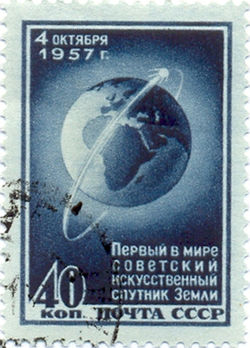Sputnik program
2007 Schools Wikipedia Selection. Related subjects: Space transport
The Sputnik program was a series of unmanned space missions launched by the Soviet Union in the late 1950s to demonstrate the viability of artificial satellites. The name "Спутник" is Russian, and means "fellow traveler," and "satellite." The Russian pronunciation is /ˈsputnʲɪk/, but the usual pronunciation in English is /ˈspʊtnɪk/ or / ˈspʌtnɪk/.
Sputnik 1, the first artificial satellite , was launched on October 4, 1957.The world's first artificial satellite was about the size of a basketball, weighed only 183 pounds, and took about 98 minutes to orbit the Earth on its elliptical path
Sputnik 2 was launched on November 3, 1957 and carried the first living passenger, a dog named Laika. The mission planners did not provide for the safe return of the spacecraft or its passenger, making Laika the first space casualty.
The first attempt to launch Sputnik 3, on February 3, 1958, failed, but the second on May 15 succeeded, and it carried a large array of instruments for geophysical research. Its tape recorder failed, however, making it unable to measure the Van Allen radiation belts.
Sputnik 4 was launched two years later, on May 15, 1960.
Sputnik 5 was launched on August 19, 1960 with the dogs Belka and Strelka, 40 mice, 2 rats and a variety of plants on board. The spacecraft returned to earth the next day and all animals were recovered safely.
All Sputniks were carried to orbit by the R-7 launch vehicle, originally designed to carry nuclear warheads.
The surprise launch of Sputnik 1, coupled with the spectacular failure of the first two Project Vanguard launch attempts, shocked the United States, which responded with a number of early satellite launches, including Explorer I, Project SCORE, Advanced Research Projects Agency and Courier 1B. Sputnik also led to the creation of NASA and major increases in U.S. Government spending on scientific research and education. See: Sputnik crisis.
The launch of Sputnik 1 inspired writer Herb Caen to coin the term " beatnik" in an article about the Beat Generation in the San Francisco Chronicle on April 2, 1958.
Sputnik 40-41
Sputnik 40 (Object 24958/97058C) was a ⅓-scale model amateur radio AMSAT satellite launched from the Mir space station on 3 November 1997 to commemorate the 40th anniversary of Sputnik 1. Its appearance resembled Sputnik I. Its batteries expired on 29 December 1997 and the VHF transmitter fell silent.
Sputnik 41 was launched a year later, on 10 November 1998. It also carried an amateur radio transmitter.
List of Sputnik satellites
| Sputnik Program | ||
|---|---|---|
| Sputnik 1 Sputnik 2 |
Sputnik 10 Sputnik 19 |
Sputnik 20 Sputnik 21 |

